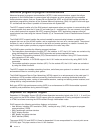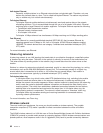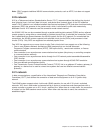v Frame relay direct network: Allows data that uses SNA, TCP/IP, or IPX communications over a
frame-relay network to move at speeds of up to 2.048 Mbps. This support allows a network of systems
to communicate using the frame-relay network as a backbone, without the need for multiple leased T1
lines.
v Bridged frame relay network: Allows AS/400 to communicate over a frame-relay network through a
remote bridge. The bridge is attached to a token-ring, Ethernet, or distributed data interface (DDI)
network. Bridged frame relay connections allow AS/400 to communicate with stations on the remote
local area network (LAN) as if they were attached locally to the LAN medium.
For more information, see Frame relay.
Integrated services digital network
You can connect your AS/400 to an Integrated Services Digital Network (ISDN) for faster, more accurate
data transmission. An ISDN is a public or private digital communications network that can support data,
fax, image, and otherservices over the same physical interface. Also, you can use other protocols on
ISDN, such as ISDN data link control (IDLC), PPP, fax, and X.25.
ISDN provides benefits that are not found in more conventional types of communications. These include
the following:
v High speed, low error rate communications
v Switched, high speed communications
v Switched, digital networking
v Advanced networking functions
v Integration of voice and data transmissions
v Integrated support of packet switching (X.31)
For more information on ISDN, see the topics ISDN on AS/400 and ISDN data link control network.
ISDN data link control network
You can use ISDN data link control (IDLC) to connect two systems to exchange information over an ISDN
B-channel.
IDLC complies with the data link control protocols that are defined in CCITT Recommendations Q.921 and
Q.922. IDLC defines a set of protocol rules and formats for use on D-channels and B-channels. On the
D-channel, IDLC provides a reliable link with the network equipment. On the B-channel, IDLC provides a
reliable link with another end user.
Similar to other data link protocols, IDLC has special considerations for operation:
v IDLC parameters used to establish the logical connection
v Delayed contact for permanent connection
v Frame size related to performance
v Disconnect parameters for a switched IDLC controller
Synchronous data link control network
SDLC has the following meanings:
v A form of communications line control that uses commands to control the transfer of data over a
communications line.
v A communications discipline that conforms to subsets of the Advanced Data Communication Control
Procedures (ADCCP) of the American National Standards Institute (ANSI) and high-level data link
control (HDLC). These standards are part of the International Organization of Standardization.
SDLC is used for transferring synchronous, code-transparent, serial-by-bit information over a
communications line. Transmission exchanges may be duplex or half-duplex over switched or nonswitched
lines. The configuration of the connection may be point-to-point, multipoint, or loop.
94 Version 5


















